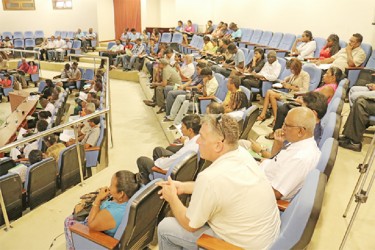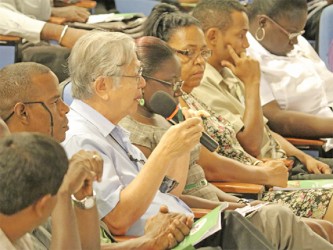President of the Guyana Agro-Processing Associa-tion (GAPA), Ramanand Prashad, says the high cost for electricity supplied by the Guyana Power and Light Inc (GPL) has led to local agro-processed products being costly.
Speaking at an Agro-Processor’s Forum, held at the International Conference Centre, Liliendaal, on Friday, Prashad said that costing agro-processed products not only included land acquisition but also the other factors used every day in agro-processing operations.
He cited electricity as the number one factor leading to higher costs of locally produced products because it increases production costs tremendously. “We have not heard anything directly in relation to electricity from those involved, but I am hoping this forum will bring out some results,” Prashad said.

Prashad said there are a few non-governmental institutions which he hopes are willing to help in whatever way they can to assist agro-processors to find ways to lower operational costs to reduce overheads.
He also suggested the use of alternative energy sources such as solar power to lower the costs of agro-processing.
These comments were in response to the questions and suggestions by Dr Leslie Chin, Chairman of Sterling Products’ Board of Directors.
Chin said that many sessions and forums such as Friday’s Agro-Processor’s Forum Agenda have been held, from which nothing much has resulted. He added that he felt that the challenges were the backward linkages and the cost of producing raw materials.
He observed that much of the inputs for agro-processing were foreign materials. He stated that a probable reason for that was because it was easier to acquire foreign materials which also were often lower in cost, had a standard quality and a reliable supply was available. He added that satisfying those criteria from inputs available from the local market was a major issue.
He suggested acquiring materials locally that could be reliably supplied and had a competitive cost internationally such as sugar and rice, to be used for agro-processing.

“Rice is the lowest cost food you can really get, plantain is seven times more costly and cassava is four time more costly and 1½ percent of the protein consumed by Guyanese is from rice,” Chin said. He added that if agro-processors were to get involved in the use of the by-product of rice (broken rice), an industry could be built.
He amplified on the use of by-products or waste of the coconut industry such as the coconut husk, water and shell that could be used as raw material for enterprises.
Raymond Trotz of Phoenix Enterprises, a company that bottles coconut water, also made an observation at the forum.
He said that small businesses in agro-processing struggle to survive because of limited financial resources.
“We must have an understanding of what it would cost to produce a unit of a specific item because that has an impact on price. This needs to be analysed by

small businesses in agro-processing so they can make decisions as to what cost needs to be cut back on,” Trotz said.
He suggested that small businesses should be given training or orientation sessions on joint ventures and business growth because as small businesses develop, they may not have the resources to expand and larger businesses may capitalise and take over.





